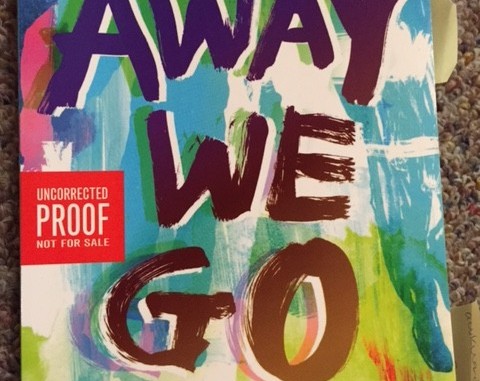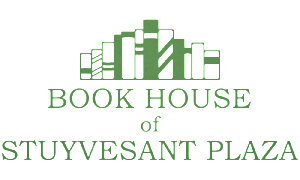
 As part of our ongoing collaboration with the Book House of Stuyvesant Plaza, our writers have accepted the challenge of reading and reviewing pre-publication review copies of highly anticipated young adult literature. The reviews are posted here for our readers, but also will be sent to the Book House where they will hopefully be used to inform customers about the books they may want to purchase.We will try to publish one review a week for the spring.
As part of our ongoing collaboration with the Book House of Stuyvesant Plaza, our writers have accepted the challenge of reading and reviewing pre-publication review copies of highly anticipated young adult literature. The reviews are posted here for our readers, but also will be sent to the Book House where they will hopefully be used to inform customers about the books they may want to purchase.We will try to publish one review a week for the spring.
The reviews contain spoilers, so be forewarned!
Away We Go
by Emil Ostrovski
Published February, 2016
270 pages, Greenwillow Books
The first thing you should know about the author Emil Ostrovski, is that his debut novel was a Fall 2013 Indie Next Pick. Away We Go was very much an “Indie” novel as well, one that will probably be a big hit once it’s published. It takes place in a universe where a pandemic appropriately named Peter Pan Virus (PPV), has infected a great number of kids across the country, causing them to die as teenagers. Barely anyone infected makes it to 19, almost no one to 20 years old. In response to this contagious and fatal disease, the government sets up recovery centers around the country, which are basically schools for them to live out their final days at, with other PPV sufferers. All the recovery centers include AwayWeGo, a social network that dictates what they’re allowed to see, and connects all the sufferers in the school together. There are treatments to prolong their lives, but the pills have side effects, different for each person. The main character, Noah, is 15 and the pills give him Leprosy as a side effect. Once someone is diagnosed with PPV, they’re whisked away to a treatment center, no contact allowed with the outside world including parents, and are forced to attend classes like they’re preparing for a future, even though no one will live long enough to get one.
We first meet the protagonist Noah in the bathroom/makeshift library of the Richmond Youth Recovery Center, arguing with his friend Alex about history’s greatest authors and whether or not to take an intelligence test to possibly get into a better recovery center. They both end up taking the test, and Noah is qualified to transfer to Westing, the most prestigious recovery center, while Alex is not. In the beginning of the novel, dialogue between Noah and his unrequited love interest Alex seemed forced and ironic. For the first few chapters, I felt the book was unorganized, as you are thrown into situations with the speaker telling you who to like without the reader actually getting the chance to decide for themselves.
At Westing Recovery Center, we as readers are plopped down with Noah into his new group of friends, a few weeks after he meets them. Thankfully, as the book goes on, the writing and dialogue gets less awkward and more realistic. But first we are introduced to Zach, Noah’s second love interest, with Noah already head-over-heels for the guy. It’s kind of hard to get on board with liking someone if we don’t know them, so it takes a while to warm up to him and the other characters. Noah and his friends are existentialists, and sometimes pretentious. But existentialism is hard to avoid when you’re diagnosed with a terminal disease- and a comet is predicted to hit the Earth.
Existentialism, irony, grief, and struggle are prominent themes for the novel. Constant allusions are also being made to famous pieces of literature, such as Whitman’s “When I Heard the Learn’d Astronomer” and of course Peter Pan, a boy who wanted to stay young forever. Noah often wishes he was Peter Pan, who could escape to Neverland, desperately wanting to flee his own reality. Noah is a satirical character, depressed about his imminent death and its irrelevance to the world. “The faster I ran, the more my body ached, the easier it was to pretend that I was a physical thing, that I had weight and solidity, a body, and that this body had somewhere to run away to, that it was worth running at all”(49).
As we meet Noah’s friends, we see how each individual suffers mentally (coping with being terminally ill) and physically (side effects of treatment). Both are very painful and obvious. They discuss Westing’s true intentions, wonder where the “Departees” are taken once the school can no longer care for them, and ask why they can’t have any contact with the outside world. The teens talk of rebellion and escape, reminding the reader of The Hunger Games or The Maze Runner, (if they were hipsters and more focused on sarcasm than spilling blood). With parties, alcohol abuse, foul language, sexual encounters, escaping to virtual realities and love of metaphors, these characters are more related to personas of a John Green novel than anything else. “I felt cold and distant and free-floating, like a feather on Pluto, why had he invited me here only to ignore me?”(72). There is a lot of teen drama, angst, and self exploration in Ostrovski’s novel, as kids try to discover what their place in the universe is as they’re about to leave it.
The troubled teens soon hatch a plan to escape, but they are discovered, although no one saw their faces well enough to pick them out of a crowd. Marty, a boy who climbed to the top of the ladder they would’ve used to escape the walls of Westing, had looked beyond the school, sadly reporting that all he saw was snow. Marty is perhaps the most interesting character in the novel because you don’t learn much about him, and the things you do learn, you love. He loves to write plays to “create holy things,” something just as good as the Greek warriors in the sky, some new religion he can believe in. He is a loyal friend, and adores constellations. He ends up as a martyr in the end, his death prompting Westing to explain why they are locked inside, and to reinvent their social network to be more honest with the people inside, because they owe them that much.
As everyone is grieving for Marty, the comet (labeled “The Great Cliche” by Noah) is still heading towards Earth. On the day the comet is due, Noah drags Zach, who can no longer feel his legs, to the top of a building to watch the world end. As the comet passes by the planet, Noah admits he is disappointed that he’s still there in a dying body, as his easy solution passes by without a scrape. Zach, so close to death, commits suicide and Noah must live on knowing that their chance at romance was only a story just as the comet was, and just like Peter Pan. There was no conspiracy afoot, just a bunch of sick kids coping with the fact that leaving Westing’s walls means infecting others. “We are weak and small before the great tragic powers of the world, and so are our parents, and so are our friends; we will never know why some kids get sick and some kids do not; we will never know where away we go,”(265). Yes, it’s kind of depressing, but it’s honest and beautiful in a way that this disoriented 16 year old comes to term with his life and his death. In a tribute to Marty, Zach, everyone who has died from PPV, and those who wanted the comet to end it all, Noah pays tribute by stealing confiscated fireworks and setting them off on a hill besides the school. The lights explode and Noah is happy for a moment, because he has brought a piece of Neverland to life, and says those iconic words of Peter Pan: “To die will be an awfully big adventure.”
Overall, I enjoyed Away We Go, although it had a rocky beginning. The dialogue was sometimes pretentious, but then again I am not as well versed in the writings mentioned as the author clearly is. The characters came to life through the pages and you can feel their anger, turmoil, sadness, and desperation. The references to Peter Pan were well placed throughout the novel, and the aspect of “liking all the wrong people” made for intense drama, because you as the reader wish them the best because you know their deaths are coming. Ostrovski’s novel is heavy and thought provoking, but also humorous and reflective.
